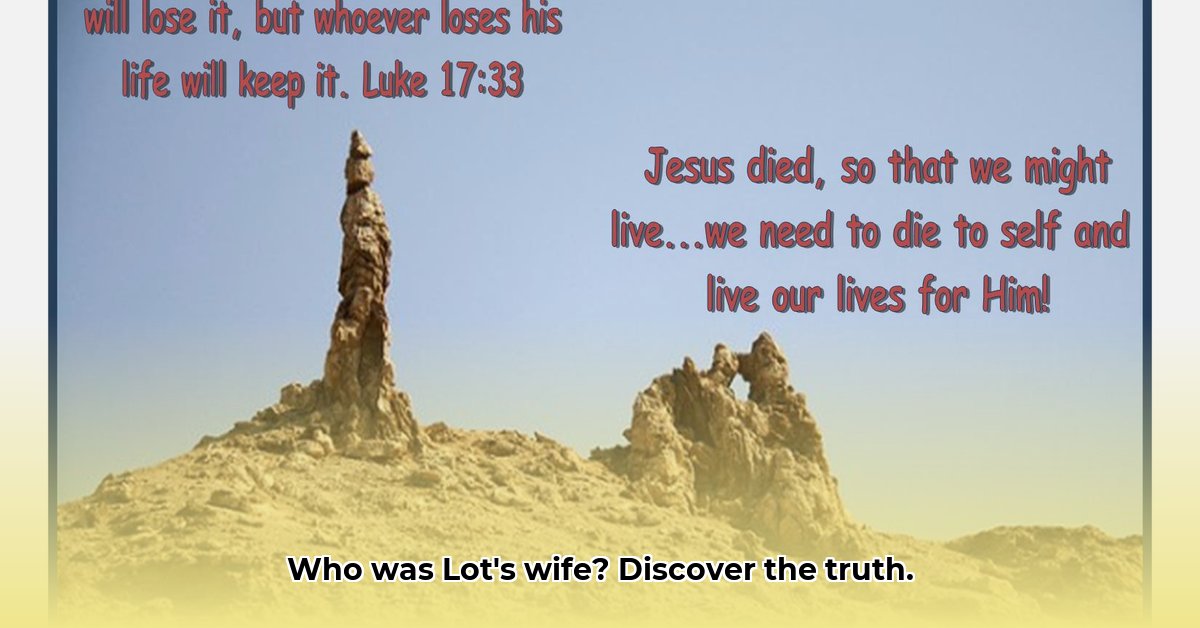The tale of Lot’s wife, a figure forever frozen in the biblical narrative of Sodom and Gomorrah’s destruction, continues to fascinate and haunt. More than just a cautionary tale of disobedience, her unnamed presence whispers of complex human emotions: loss, longing, and the agonizing struggle between past and future. This exploration delves beyond the surface of the biblical account, examining the multifaceted interpretations of her story and its enduring relevance in contemporary life. For more on understanding loss and grief, see this helpful resource.
Beyond Disobedience: Exploring the Human Dimensions of Lot’s Wife
The Genesis 19 account paints a stark picture: a divine command to flee without looking back, a wife’s fateful glance, and the chilling consequence – transformation into a pillar of salt. The narrative’s brevity and silence on her inner life create a void readily filled with speculation and interpretation. This very ambiguity invites us to consider the woman behind the salt, her motivations, and the profound emotional turmoil that may have driven her final act. Was it mere defiance, or a deeper, more relatable human response to unimaginable loss?
A Wife, A Mother, A Refugee: Reconstructing Lot’s Wife’s World
Lot’s wife wasn’t just a nameless figure in a biblical story; she was a woman embedded in a specific time and place. She was a wife, likely a mother, and suddenly a refugee forced to abandon her home, her community, and everything she knew. Imagine the emotional weight of that sudden displacement, the fear and uncertainty of the unknown future. This contextualization helps humanize her, transforming her from a symbol of disobedience into a complex individual grappling with a traumatic experience. Her story becomes a reflection of the refugee experience throughout history, echoing the pain of displacement and the struggle to adapt to a new life. Consider the parallels to modern refugee crises, the women forced to leave their homes, carrying the weight of loss and uncertainty.
The “Look Back”: A Language of Loss and Longing
The act of looking back, so heavily laden with symbolic meaning, can be interpreted through multiple lenses. It’s not simply an act of disobedience, but a visceral human reaction to loss. Imagine leaving behind everything you’ve ever known – your home, your friends, your entire life. That backward glance becomes a silent farewell, an acknowledgment of the profound rupture from the past. It speaks to the powerful pull of memory, the enduring connection to place, and the agonizing struggle to let go. This interpretation reframes Lot’s wife not as a rebellious figure, but as a grieving one, her gaze a testament to the human cost of destruction.
Expanding the Narrative: Insights from Jewish Tradition
Jewish tradition, through Midrash and Aggadah, offers a richer, more nuanced understanding of Lot’s wife. Some interpretations suggest her transgression stemmed from a lack of hospitality or a deep-seated attachment to the materialistic comforts of Sodom. Other accounts offer a more empathetic portrayal, highlighting her concern for her married daughters left behind or her terror at witnessing the divine wrath unleashed upon her city. These diverse perspectives reveal the fluidity of interpretation, demonstrating how religious narratives can be re-examined and reinterpreted to offer new insights into human behavior and divine justice.
A Timeless Mirror: Lot’s Wife in Art and Literature
Across centuries, artists and writers have been drawn to the enigmatic figure of Lot’s wife, transforming her into a potent symbol in art and literature. Sculptures, paintings, poems, and plays have depicted her as a figure of tragedy, a warning against disobedience, and a symbol of longing for the past. These varied interpretations demonstrate the enduring power of her story to resonate with diverse audiences, reflecting evolving cultural values and perspectives on gender, obedience, and the human condition. Exploring these artistic representations provides a fascinating lens through which to examine how societies have grappled with themes of loss, punishment, and the consequences of choices.
Embracing the Unknown: Lessons for the Modern Age
The story of Lot’s wife continues to resonate in the 21st century, offering valuable lessons about navigating change, embracing the unknown, and finding strength in the face of adversity. Her experience serves as a reminder of the importance of adapting to new realities, even when painful, and the dangers of clinging to the past. Her story also prompts reflection on our own attachments, our struggles with loss, and the choices we make when confronted with difficult transitions. By understanding the human dimensions of her tragedy, we can glean wisdom for navigating our own journeys of change and loss.
- Unlock Filipino Culture: A Deep Dive into Traditions and Practices - April 23, 2025
- Unlock Spanish Culture: Insights & Opportunities Now - April 23, 2025
- White Spirit Uses & Substitutes: A Deep Dive for Pros & DIYers - April 23, 2025
















